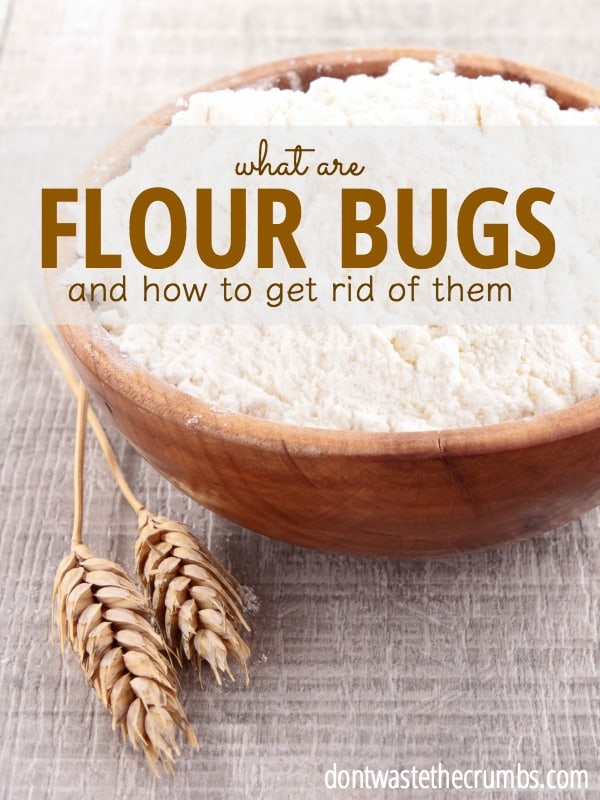
Have you ever noticed flour bugs in your rice, cereal or pasta? Let’s talk about what they are exactly, how they got there, whether or not it’s safe to eat the food and what you can do to keep them from coming back!
Buying items in bulk is one of the best grocery saving tips that continues to work month after month, but I do wonder if the 50 pounds of flour sitting in my closet (in it’s original thick paper bag) is the best way to store it.
Growing up, my mom had mentioned something about flour bugs, but I’ve never seen them before. Or maybe I’ve just never noticed them before?
I admit – seeing flour bugs or even bugs in your whole grains, rice and pasta can be pretty gross – but all is not lost and in fact, it’s pretty common!
Why am I finding flour bugs?
This is a pretty loaded question, and one that often comes with more questions too. The best way I can think of addressing it all is to lay it all out, question-and-answer style.
Does flour go bad?
The short answer: Yes.
The long answer: The more processed the flour is, the longer it takes to go bad.
Flour is made from a whole grain, with the most common whole grain being wheat. Once the grain is no longer whole, the oils from the outer portion of the grain can go rancid (or sour, stale, etc.).
Freshly milled flour will go rancid much more quickly than store-bought all-purpose flour will. That’s because freshly milled flour will contain both the germ and the bran (natural oils are found in both of these places). All-purpose flour though, only contains the endosperm and very little oils.
This is why home bakers who grind their own wheat will make flour just before they use them in recipes.
Related: How to make flour without a grain mill
Where should we store flour?
Going back to the level of processing, all-purpose and other non-whole grain flours can be stored in a cool, dry place without any issues for about one year.
Whole grain flours should be kept in a refrigerator for the short term, about 2-5 days. If you need to store whole grain flour for longer than a handful of days, the freezer is the best place.
How should we store flour?
If the flour will be used fairly quickly, it can be left open or in a container with a lid.
Think about local bakeries and delis – they’ll often have a bucket of flour open on the counter or a lid may be slightly ajar. They will use a good bit of flour in a single day, so sealing it up tight isn’t an issue.
If the flour will be used within a month or two, it should be kept in a sealed container.
One to two months is considered “quick” in terms of flour usage, so you can keep your flour in a container that is NOT sealed (i.e. the same thick paper bag, rolled down) but the chances of the flour going rancid increase.
If the flour will not be completely consumed within two months, it should be stored in a sealed container.
What type of storage container is best for flour?
Depending on the quantity of flour on hand, there are food-grade buckets are available in a wide variety of sizes.
1 gallon buckets with lids would be best for daily use or the pantry. They’re light enough to move from counter to pantry and back, but big enough so that you’re not constantly refilling the flour every time you make bread.
3.5 gallon buckets with lids are best for keeping on the floor of the pantry or in a nearby closet. This is where you’d keep the majority of the flour, refilling the 1 gallon bucket with the flour from the 3.5 gallon bucket. These will be too heavy to easily use in daily baking, but not so heavy that you couldn’t slide it on the floor or pick it up if you absolutely had to.
5 gallon buckets with lids are best for long-term storage in a basement or garage or excess pantry. This size will be too big for most people, but is ideal for those who buy whole grains in bulk. You’d keep your whole grains in this bucket and bring the smaller 3.5 gallon bucket to this one when it’s empty for a refill. Then you’d grind your flour and fill up the small 1 gallon bucket.

Why are there flour bugs in grains?
If you notice little brown bugs in your flour, cereal, grain or rice, those are called weevils. Weevils look like little grains of rice, but they’re brown and they move. On their own.
Ever notice your flour tangled in something that looks like a cobweb? That means your flour is infested too.
Have no fear – flour bugs don’t just suddenly appear in your flour one day because you forgot to mop some mysterious sticky substance that one of your children accidentally spilled in your pantry. If you see flour bugs, they were already there when you bought it.
The female weevil lays eggs in the wheat kernel and it can sometimes survive the milling process. The eggs will hatch if they’re in warm or humid conditions, or have reached their maturity. The flour bugs eat the grain and then seek to mate… while eating more grain.
Why are there flour bugs in my boxed cereal?
Weevils aren’t particular about what they eat. If you find them in any other seemingly sealed spot, they’ve weaseled their way out of their original infestation spot and meandered to your rice, or cereal, or coffee.
Essentially, this means what you’ve already eaten was infested too.
Weevils are also not particular about containers. Thin cardboard boxes that cereal comes in, thin paper bags that flour comes in and even the plastic bags inside cereal and cracker boxes are no match for weevils.
The best containers to keep your dry goods in while keeping weevils out are these food-grade containers with lids that seal:
What can I do to prevent eating beetles?
1. Clean the Area.
First, get rid of the infested item.
Remove everything from the area, vacuum out any cracks and sanitize the shelves with white vinegar. If you’re sensitive to the smell of vinegar, make citrus-infused vinegar instead.
Check areas regularly for re-infestation as it may take awhile to completely rid of all flour bugs and larvae, and clean your storage area regularly.
2. Store dry goods properly.
Freeze newly purchased grains and flour for at least three days to kill any eggs. Some sources recommend freezing for up to one week. (Note that freezing will kill the eggs, but not remove them.)
As a general guideline, don’t buy more grain than you will use within four months. Store grains in a tightly sealed container, not a bag. Weevils are HUNGRY little devils and can eat through bags. (See my storage recommendations above).
3. Prevent Future Infestation
Adding whole bay leaves and garlic cloves to the area seems to deter flour bugs from setting up shop in your pantry. Garlic may leave a trace flavor in your baked goods, so if you don’t want that, go for the bay leaves instead.
Other Ideas for Preventing Flour Bugs
I haven’t tested all of these ideas myself, but if bay leaves and/or tea tree oil haven’t worked for you, readers also suggest:
- Food grade Diatomaceous Earth
- Lock & Lock Food Storage Bins
- Applying tea tree oil to a few cotton balls and place them throughout the pantry
- Dried Chilis
Will eating beetles harm me?
Other than give you the heebie jeebies, they’re harmless. In fact, the heat from baking kills the eggs and any beetles that may have made their way into your batter. So while the odds of us eating weevils – or have eaten weevils in the past – are high, the mortality rate is low.
Flour Bugs are very common. But there are ways to prevent them from showing up.
- Store your flour in food grade buckets with sealed lids – use 1-gallon, 3.5-gallon, or 5-gallon depending on where you are storing and how often you access your flour. Same goes for grain. (These storage bins would work well for everyday use.)
- Make sure to keep your pantry or storage area clean. Add bay leaves and garlic, cotton balls soaked in tea tree oil, or sprinkle the area with diatomaceous earth.
- Don’t sweat too much if you find evidence of the bugs. They won’t harm you! It’s just not too fun to eat bugs…
Want to learn why you should stock your pantry with grain or flour? A well stocked pantry is part of keeping your real food budget low! Buying in bulk and stockpiling is one of the key lessons in Grocery Budget Bootcamp, my signature eCourse for affording real food on a budget. The principles I teach in GBB are the real life ways I keep my family budget at $330 a month! Learn more HERE.
Grocery Budget Bootcamp enrollment is currently closed, but you can join my FREE 5-day Crush Inflation Challenge and start saving money on groceries tomorrow!







I don’t see these black little bugs, I see super tiny light brown ones. Only way to see them is if they move. Sometimes I need to use my flashlight to make sure what I’m seeing. They are like size of a dot. At least rice can be washed but I can’t use flour with bugs, I can’t sleep at night. I use bay leaf and send to keep them away but I just opened a new package that’s been sitting for two weeks and I already see bugs.. returning to store
I purchased 2 small bags of 00 flour 2 weeks ago, which I hadn’t opened yet. When I opened one this morning there was one of the bugs right on top of the flour. This has never happened to a new bag I’m shocked. The bag has an expiration date of 2025. Returning right back to the store today.
White rice is the product I will usually find infected. I know the little varmits are already in the rice when I buy it. I do transfer the rice to a container with a tight lid at home. If I don’t use it up quickly, I will find a brown residue in the bottom of the container in a month or so, and out it goes. As for brown rice, I always store it in the freezer. That prevents the bloom and keeps the rice in good condition.
When I first got married years ago in 1976, I never heard of bugs in the flour. So imagine my disgust the first time I found them in my flour. Since then I have put everything I think weevils can live in, in the freezer with the exception of rice. I have never heard of bugs in rice until I read this column. I will start freezing my rice. But the reason I am writing is because I usually only freeze my stuff for 48 hours. That has always been long enough for me. I will leave packages longer if I have the room & don’t need the product yet but, 48 hours is usually long enough. Maybe it has to do with time of year & location whether or not it needs freezing longer. I live in Sparks, Nevada. It’s a suburb of Reno. I tend to do more baking in winter than I do in summer. It gets very hot here in summer. Well, that is my 2 cents.
If you freeze newly purchased grain or flour products initially, does it not cause a moisture/mold problem once they are removed from the freezer and stored in the pantry?
I have never had a moisture/mold problem. Maybe it is because I never leave stuff in its original container, which is usually a bag. I always put it in a hard sided container with a screw on lid or somethind air tight.
I noticed these nasties and cleaned out everything in the pantry but kept the cling wrap and baking paper. Should I have thrown these out? It’s now been a week and can see they have returned!
Hi Amy,
I haven’t found them to live on the cling wrap, but that’s not to say they couldn’t or wouldn’t. I’d hate to tell you to waste these things, but maybe you can inspect them well? Hope this helps.
I had my flour in a ceramic canister and those bugs were in there. What can I do?
Found a colony of these little black bugs in my flour for the first time today. Busily crawling on the top layer of the bottom 1/5 of a 10kg bag of flour, opened probably 3 months ago and stored at room temp in the original paper package with the top open. Used a sieve to remove most (I think!) of them but will plan on purchasing a sealed bucket/container for my next 10kg bag of flour! That size usually lasts about 4-5 months in this house, depending on how much bread is being made. Thanks for confirming that they are “harmless” but they give me the icky vibe nevertheless and will avoid letting them flourish in future.
I have found that oxygen removers also helps keep the critters out of site.